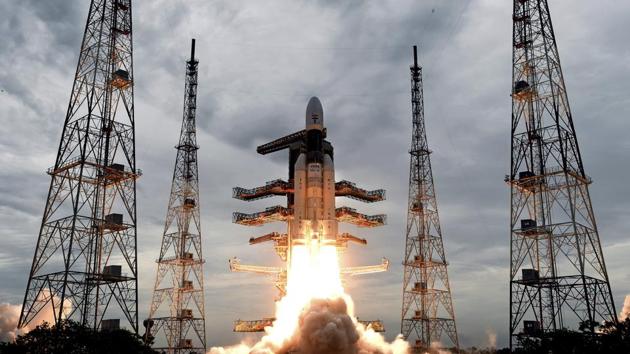Chandrayaan 2 enters lunar orbit, ‘biggest milestone’ achieved
India’s second moon mission, Chandrayaan 2, carries 13 Indian scientific instruments for experiments. Imaging of rock will be done to find elements like magnesium, calcium and iron and also for signs of water.
India’s second mission to moon Chandrayaan 2 achieved the “biggest milestone” as it entered the lunar orbit on Tuesday, a tense operation only next to the 15 minutes of terror scientists will experience on September 7 when the lander-rover starts a descent to the moon.

This critical manoeuvre comes on Day 30 after the launch of the mission on July 22. Scientists at Indian Space Research Agency (Isro) fired the propulsion system onboard Chandrayaan 2 in 1738 seconds to achieve a highly elliptical orbit of 114x18,072 km at 9.02am on Tuesday.
“This was an extremely critical point in the mission, I would say the biggest milestone only second to the lunar landing. The moon is a moving object and so is our spacecraft. To ensure lunar capture, several parameters such as the velocity and the inclination had to be precise,” an Isro official said on the condition of anonymity.
Follow live updates here
After this, the scientists will perform four more manoeuvres to reduce the orbit of the spacecraft around the moon to a circular nearly 100x100km orbit. The manoeuvers will take place on August 21, August 28, August 30, and September 1.
In the final orbit, the orbiter will continue revolving around the moon, collecting data for a year. The Vikram lander and Pragyan rover will separate out of the orbiter on September 2, after which two more manoeuvres will bring it closer to the lunar surface before it starts its powered descent on Day 48 after the launch.
Two orbit manoeuvres will be performed on the lander before the initiation of powered descent to make a soft landing on the lunar surface on September 7, according to the agency said.
Chandrayaan 2 had entered the Lunar Transfer Trajectory on August 14 after final orbit raising manoeuvre of the spacecraft was successfully carried out.
Chandrayaan 2 lifted off on July 22 onboard Isro’s most powerful launcher, the 640-tonne rocket Geosynchronous Satellite Launch Vehicle-Mark III (GSLV-Mk III), from the country’s only launch site Satish Dhawan Space Centre.
The health of the spacecraft is being continuously monitored from the Mission Operations Complex (MOX) at Isro Telemetry, Tracking and Command Network (ISTRAC) in Bengaluru with support from Indian Deep Space Network (IDSN) antennas at Byalalu near the capital of Karnataka.
The ₹978 crore mission carries 13 Indian scientific instruments for experiments. Imaging of rock will be done to find elements like magnesium, calcium and iron and also for signs of water. Mission will also study the exosphere of the moon.
All systems onboard Chandrayaan 2 spacecraft are performing normal, Isro said on August 14. It said Chandrayaan 2 will shed light on a completely unexplored region of the moon, its South Pole.
“This mission will help us gain a better understanding of the origin and evolution of the Moon by conducting detailed topographical studies, comprehensive mineralogical analyses, and a host of other experiments on the lunar surface,” the space agency has said.
If the landing goes successfully, India will become the fourth country after the US, the erstwhile USSR, and China to land on the moon. It will also be the first time a lander-rover will explore the South Pole of the moon. It will also be the year’s third bid at a moon landing, following China’s successful launch of a lunar probe and the Israeli Beresheet spacecraft, which failed and crashed on the moon in April.
The mission comes 11 years after Chandrayaan-1, which was launched on October 22, 2008, and orbited the moon at a height of 100km from the lunar surface for chemical, mineralogical and photo-geologic mapping.
Get Current Updates on India News, Lok Sabha Election 2024 live, Infosys Q4 Results Live, Elections 2024, Election 2024 Date along with Latest News and Top Headlines from India and around the world.




